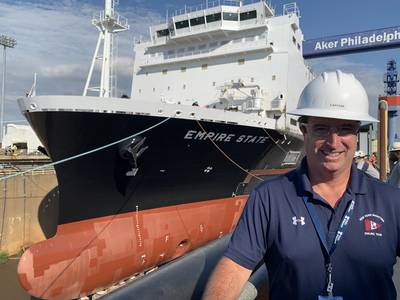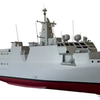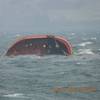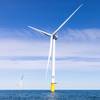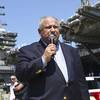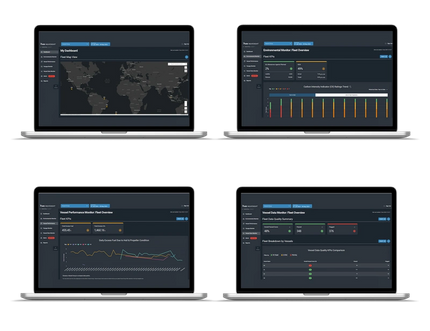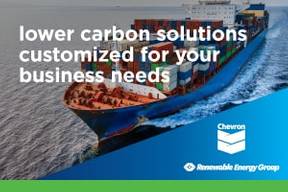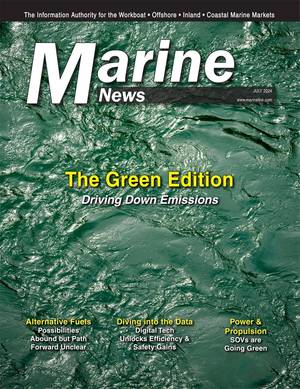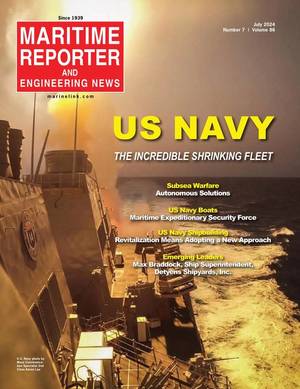Captain McManus Preps to Take the Helm of Empire State VII
Captain Morgan McManus will serve as the Ship’s Master on the Empire State VII, the first in a series of five National Security Multi-Mission Vessel (NSMV), which at press time was getting its post-sea trial finishing touches at Philly Shipyard. The project to design, build and deliver the NSMV series is one of the most exciting shipbuilding programs in the U.S. – a government shipbuilding project leveraging commercial shipbuilding efficiencies. For insights, we visited with Captain McManus to discuss the ship, it’s technology suite and its role in helping to educate a new generation of U.S. seafarers.
Captain Morgan McManus has a long and varied maritime career spanning nearly 30 years, sailing on everything from tankers to deepwater drill ships, returning in 2019 to his alma mater SUNY Maritime to serve as the captain on the schools training ship, Empire State VI.
“When I joined the college in 2019, they were still in the phases of designing and reviewing the [new] ship,” said Captain McManus. Designed from the ground up, NSMV is the first completely new-design ship for the U.S. Maritime Administration (MarAd) in decades, and the project has widely been hailed for taking a commercial – ie. more cost-efficient – approach to a government shipbuilding contract.
Five ships will be built for five maritime academies – Empire State VII for SUNY Maritime; Patriot State for Massachusetts Maritime Academy; State of Maine for Maine Maritime Academy; Lone Star State for Texas A&M Maritime Academy; and Golden State for California State University Maritime Academy – and each had input on the design, from the size and configuration of classrooms and berthing areas, all the way down to the mess deck.
“They received a lot of our input from all the schools as to what it should look like and what was needed,” said Captain McManus. “We said what we thought we needed to make a training ship a training ship.”
It’s safe to say that any ‘first-in-class’ ship comes with ample design changes and challenges, and Empire State VII is certainly no exception. Perhaps the biggest challenge though, had nothing to do with ship design itself, as first steel for Empire State VII was cut in mid-December 2020, squarely at the start of the Covid-19 pandemic and shutdown, a situation which slowed, but never stopped the process.
“It made it difficult as far as meetings and project review; a lot was done by Zoom and Teams meetings, and the yard was doing everything they could to keep work going,” said Captain McManus. “That made it challenging, trying to build a first-in-class ship with a pandemic going on.”
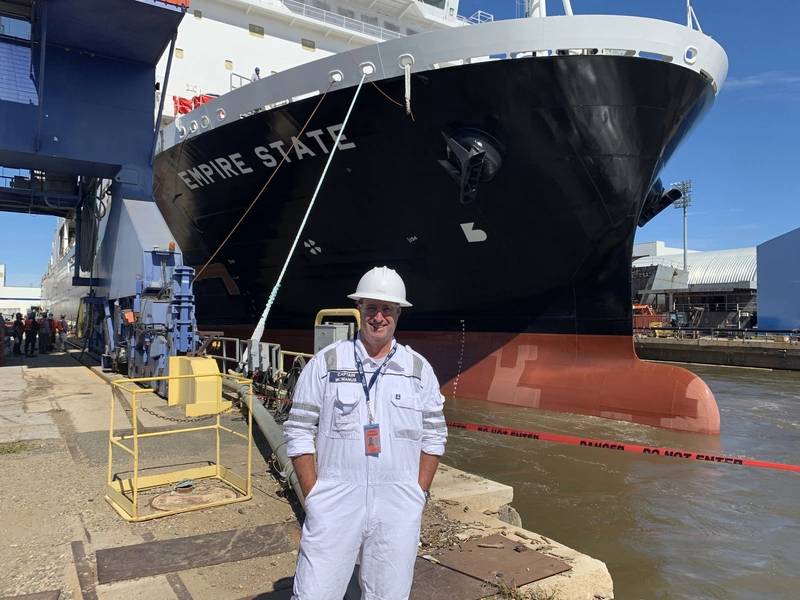 “It's built [with] redundancy for the safe return to port feature, but it also helps for training because we'll be able to take off equipment 100% offline for teaching,” said Captain McManus. “I think more importantly, the engineering students are going to get such a great working knowledge of power management systems and the computerization of the machinery, learning how reliant and how integral computer software is to engine management and power management,” which is what they’re going to see when they go out into the job market." Photo courtesy Captain Morgan McManus
“It's built [with] redundancy for the safe return to port feature, but it also helps for training because we'll be able to take off equipment 100% offline for teaching,” said Captain McManus. “I think more importantly, the engineering students are going to get such a great working knowledge of power management systems and the computerization of the machinery, learning how reliant and how integral computer software is to engine management and power management,” which is what they’re going to see when they go out into the job market." Photo courtesy Captain Morgan McManus
NSMV: A Short History
The NSMV program has a long history, as Jeff R. Vogel, Member, Cozen O'Connor, wrote in the August 2023 edition of sister-publication MarineNews. The program has transcended Presidential administrations and Congressional leaders. In 2015, MARAD engaged with the U.S. Department of Transportation’s Volpe Center to make the business case for the recapitalization of the state maritime academy training fleet. The results of the study indicated that if the government failed to take action by 2025, three of the existing training vessels would be inoperable. Volpe’s Principal Technical Advisor for Transportation Logistics and Security summarized the critical importance of finding a solution, stating, “Without the state maritime academy training ships, there would be a long-term negative impact on national security, reducing the number of credentialed mariners available to operate U.S. vessels during war, national emergencies, and for domestic and international commerce.”
That same year, MARAD began work with Herbert Engineering to develop a design for what would eventually become the NSMV. The demands on the design would be significant. In addition to have to physically fit in the berths available at the state maritime academies, and serve as a state-of-the-art training platform for up to 600 cadets at sea, the vessel design would also have to accommodate use as a humanitarian aid and disaster relief (HA/DR) platform. State maritime academy vessels being used to support HA/DR missions was, of course, not a new concept. For example, in 2012, the TS Kennedy from the Massachusetts Maritime Academy and the TS Empire State VI from SUNY Maritime College were used to house disaster relief workers during the Hurricane Sandy clean-up effort. The difference, of course, is that the NSMV was designed to specifically support HA/DR operations, incorporating a roll-on/roll-off side ramp, container space, onboard cargo handling equipment, a helipad and berthing for up to a 1,000 people.
The result was a mature design, which together with the business case from Volpe, allowed MARAD to receive Congressional funding to begin the NSMV program in earnest. However, Congress saw the value of partnering with private industry to efficiently construct these next generation dual-purpose vessels. Accordingly, the National Defense Authorization Act for Fiscal Year 2017, required “an entity other than the Maritime Administration to contract for the construction of” the NSMVs. The stated Congressional goal was to “leverage the ship construction expertise of… a commercial operator when contracting for the construction of the vessel.” This act should be viewed as a moment of divine political inspiration.
This Congressional direction led to a MARAD contract award to TOTE Services in May 2019, leveraging their deep experience in commercial vessel construction. In turn, TOTE Services awarded the initial vessel construction contract in April 2020 to Philly Shipyard.
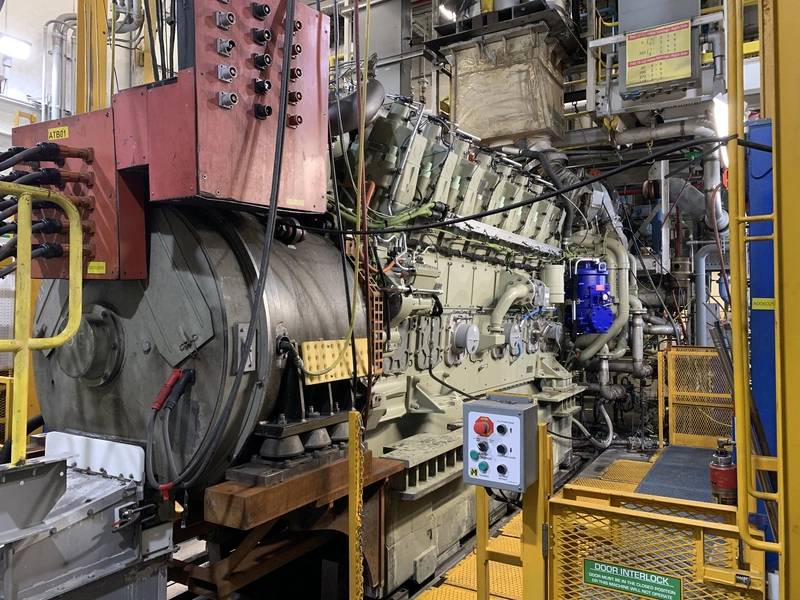 Power onboard consists of Wabtec Corporation's 16V250MDC, EPA Tier 4, IMO Tier III marine diesel engines designed to provide the power generation for the ships' electric grid, including the power and propulsion system which is supplied and integrated by GE Power Conversion. For the NSMV series, Wabtec will deliver a total of 20 x 16V250MDC Wabtec EPA T4 marine diesel engines plus accessories to its channel partner, Cummins Sales & Service, who has the job of packaging the engines into marine gensets for the five vessels.
Power onboard consists of Wabtec Corporation's 16V250MDC, EPA Tier 4, IMO Tier III marine diesel engines designed to provide the power generation for the ships' electric grid, including the power and propulsion system which is supplied and integrated by GE Power Conversion. For the NSMV series, Wabtec will deliver a total of 20 x 16V250MDC Wabtec EPA T4 marine diesel engines plus accessories to its channel partner, Cummins Sales & Service, who has the job of packaging the engines into marine gensets for the five vessels.
Photo courtesy WabtecDesigning a Modern Training Ship
Seafarer training is an ample mix of centuries of traditional seafaring skills melded with new and emerging technologies aimed at making a difficult and potentially dangerous job more efficient. The technology on this new series of ships is the show stopper, and in the case of Empire State VII the upgrade is radical, as it replaces a ship that is more than 60 years old.
Starting in the machinery space, Empire State VII has a modern diesel-electric power plant, built with redundancy in that there are two separate engine rooms with a pair of diesel generators in each, both feeding dual high voltage switchboards and dual propulsion motors.
“It's built [with] redundancy for the safe return to port feature, but it also helps for training because we'll be able to take off equipment 100% offline for teaching,” said Captain McManus. “I think more importantly, the engineering students are going to get such a great working knowledge of power management systems and the computerization of the machinery, learning how reliant and how integral computer software is to engine management and power management,” which is what they’re going to see when they go out into the job market."
Power onboard consists of Wabtec Corporation's 16V250MDC, EPA Tier 4, IMO Tier III marine diesel engines designed to provide the power generation for the ships' electric grid, including the power and propulsion system which is supplied and integrated by GE Power Conversion. For the NSMV series, Wabtec will deliver a total of 20 x 16V250MDC Wabtec EPA T4 marine diesel engines plus accessories to its channel partner, Cummins Sales & Service, who has the job of packaging the engines into marine gensets for the five vessels.
Getting schooled on the new system is a process for the instructors, too, and started well before the first ship was launched. “Training wise, we've been going through GE Power Conversion training,” said Captain McManus. “My engineers have gone out to Wabtec training school, and MarAd has been very supportive with funding training,” from the power to the bridge.
In addition, the SUNY team has been in Philadelphia at the yard since December 2022, observing testing and commissioning. “As systems were coming online, if you're right there in the beginning, you get a lot of knowledge just by watching the technicians,” said Captain McManus. Directly before our interview Captain McManus and his team participated in sea trials. “It's [taking a deep dive], immersing ourselves in design review and reviewing the blueprints and going over the ops manuals, the tech manuals for all the equipment.”
On the deck side, the ship sports a dual bridge, a separate training bridge from the main bridge “so we get more interaction going on with more students and that makes a big difference,” said Captain McManus. “The ship has a bow and a stern thruster, so the deck students are going to be able to get ship handling [experience] and familiarization with operating thrusters, firsthand in the ocean, real-world time.”
While the NSMV is purpose built for training plus emergency response when needed, Captain McManus said the vessel feels familiar to the deep water drill ships that he led previously.
“Ironically, from working on the deep water drill ships, a lot of the structure is similar, the forward house and the diesel-electric propulsion. So there are parts of the ship where I walk on, it reminds me very much of a drill ship.”
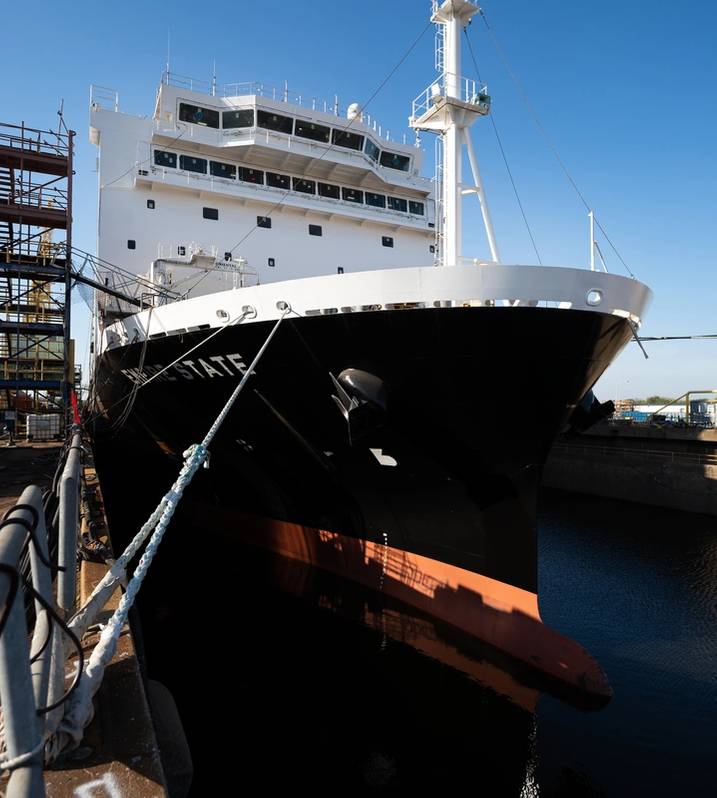 Photo courtesy Philly Shipyard
Photo courtesy Philly Shipyard
Custom Built
Not only does the NSMV replace a ship that’s 60 years old, the fact that it is custom built for training – not a cargo ship that’s been converted – makes a big difference in how all of the maritime academies will be able to structure and deliver training on the ship.
“The designers built it from the ground up, so a classroom is a classroom. I mean, if I was to drop you in a classroom and you opened your eyes, you wouldn't know you're on a ship right away because it looks like a classroom, it's great,” said Captain McManus. The difference for Captain McManus is particularly stark as he completed his mug cruise on the Empire State V, where “we had pipe racks in the cargo hold for our berthing area!”
While the new ship is a bit shorter than Empire State VI, it’s beamier, giving it a more spacious feel for everything from berthing areas to training facilities to classrooms.
In addition to regular watches and classroom training, the new ships are outfitted with dedicated simulator rooms, simulators for everything from ship handling to automation to high voltage simulators for the engineers.
Captain McManus emphasizes that another big differentiator with the new ship are the aforementioned dual bridge and the dual engine room. “You can manage more students safely for training; you can have dedicated supervision that doesn't interfere with operations; but you could also have that blend where the cadets are involved in the operations, in a controlled environment,” said Captain McManus. “An engine instructor can be in the offline ECR reviewing everything that's going on in the online ECR with a whole class, and it's going to really help transfer knowledge.”
While seafarer training has changed mightily with the evolution of technology, many core tenants remain the same.
“I remember sailing chief mate and the CargoMax program on the ship died, and we had to do everything longhand for stability; it was a car carrier,” said Captain McManus. “So I had to dust off all the math and carry on.
When I first started sailing, you didn't trust the equipment because the hardware didn't have the redundancy or the robustness to work. Now you don't trust the software because of spoofing and cyberattacks. Because of that still teach cadets how to do things the traditional way.”
The new generation of seafarers are technology 4.0 natives, and while a certain level of comfort and co-dependence on technology providing the answers has emerged for all generations, “we're always reminding them to ‘look out the window’ because that's engaging your eyes and your brain. I'll get up in the morning on the training cruise and there will be 60 cadets out shooting morning stars using a sextant, which has been in use for 300 years. They love it.”
The new Empire State VII and all of the modern technology within will help to prepare the coming generation for the real world sailing and tech which they will enter, but maintaining a balanced training portfolio is the prudent step. “It's about letting the cadets know [the new technology is] a tool, and not to be dependent on it,” said Captain McManus. “The technology is a tool to make your job easier, to make your job more efficient, to make the ship operate more efficient or safely. But it's just a tool. And sometimes that tool breaks. You need to know how to do things another way. Trust but verify is my philosophy with the students.”
Passing the Torch
As Captain Morgan McManus prepares to take the helm of Empire State VII and a new generation of seafarers, he reflects on the mentors in his career that have helped to shape his career path.
“When I was chief mate, I worked with Captain Steve Werse at Central Gulf Lines. He really taught me by his leadership style. Once I started sailing captain, I was always able to call upon him with questions or for advice. When I took the role back at the college, Captain James DeSimone, the former captain of a training ship, was a great help mentoring me and source of advice [on this position].
Also, I learned how to be a captain by working with a really good chief engineer. When I first started sailing as captain, I had a great chief engineer, Neil Reilly was older than I was, and he has since passed away. I started sail captain when I was 35, so I was young and brash [with a big] ego. He had a great, subtle way of keeping me steady.
And when it comes, eventually, to his legacy with the way he would like to be remembered by the students of today? “Never stop learning. Also, be accountable for your actions; be accountable to your mistakes. [Everyone] makes mistakes; learn from them, move on from them, but be honest about it too. We always say on the ship, ‘Don't try to hide a mistake. It's going to come out eventually.’ So just be accountable."
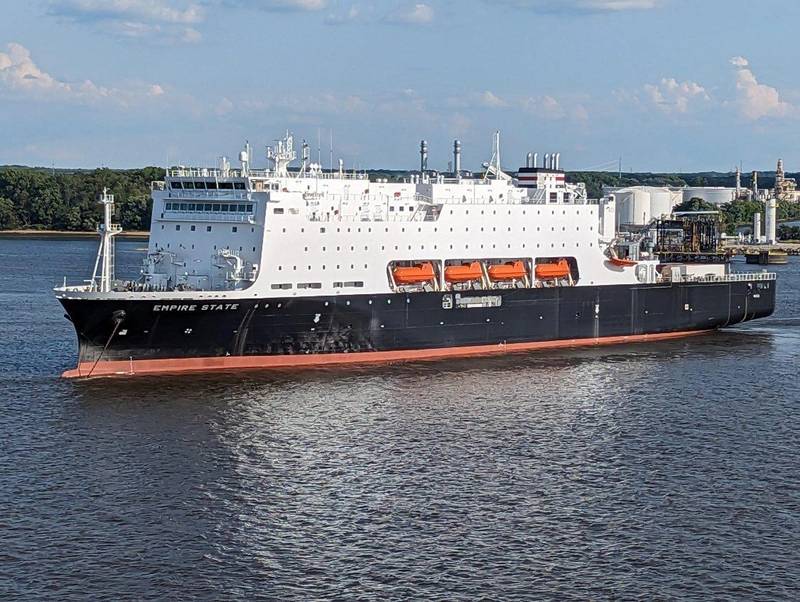 Photo courtesy Captain Morgan McManusNSMV Main Particulars
Photo courtesy Captain Morgan McManusNSMV Main Particulars
- Length // 525 ft. (160.05m)
- Breadth // 88.5 ft. (27m)
- Depth // 55.1 ft. (16.8m)
- Draft, design // 21.4 ft. (6.5m)
- Range // 10,000+ miles @ 18 knots
- Propulsion // Diesel Electric
- Engines // Wabtec (4) separated in two engine rooms
- Total installed power // 16,800 kW
- Emergency generator // 900kW
- Electric propulsion motors // 2 sets in series with an output of 9,000 kW
- Full speed // 18 knots with 15% sea margin
- Cruising speed // 12 knots with 15% sea margin
- Bow thruster // 1800 kW, retractable
- Stern thruster // 890 kW
- Rudder // Flat type
Watch the full interview with Captain Morgan McManus on Maritime Reporter TV:




